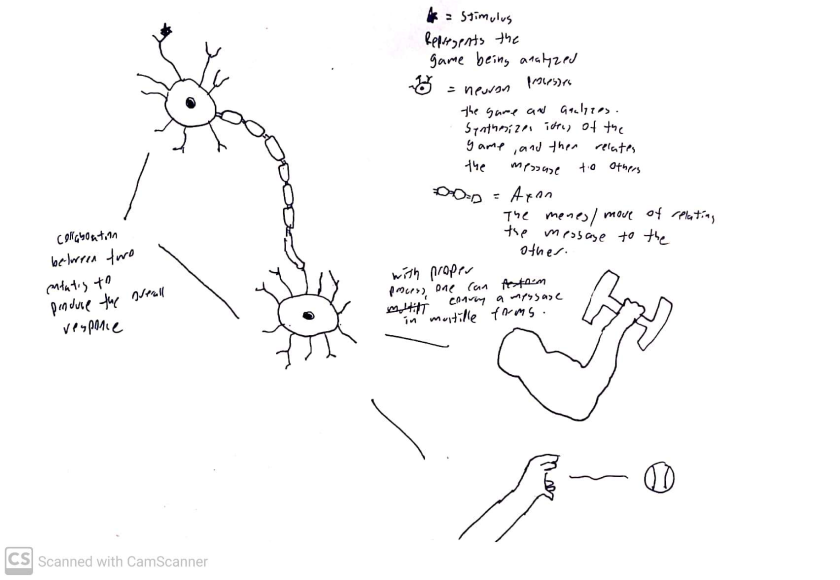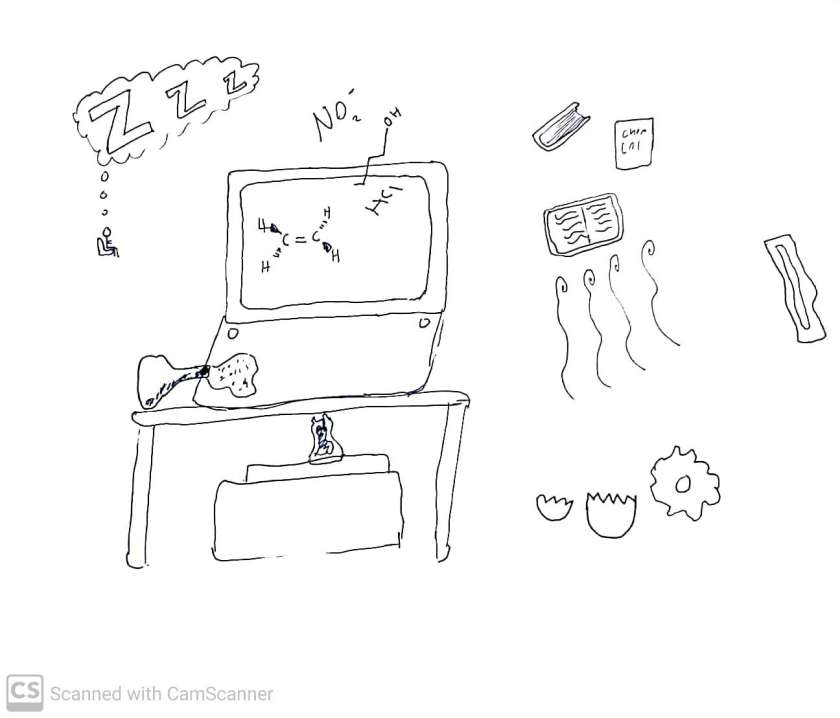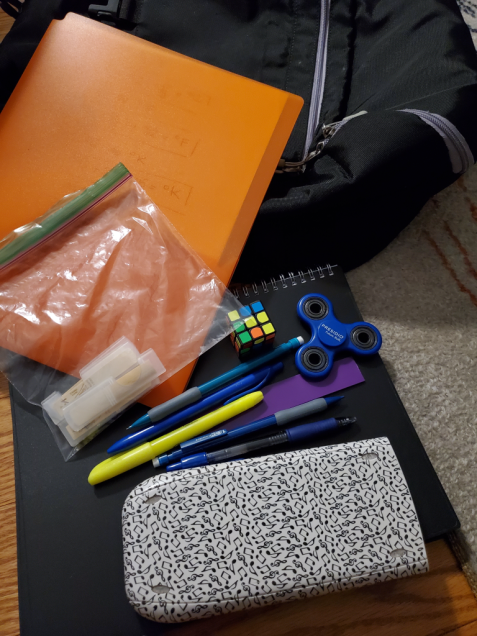Assemblies


ENG101, section 05. Fall 2020. Emory University.

My main role in creating the twine game was to create the story. I needed to establish a backstory and key character conflicts for the main character in order to progress the theme of hopelessness, perseverance, drama, and conflict during quarantine. We decided to focus on the story of the game first, and then we would move onto the mechanics of the game and putting it into twine. After the story, we wanted to think of ways we could engage the player in our game. One mechanic we hoped to include was a meter that tracked two different factors, health and resolve. These things were measured by tracking the character’s physical, mental, and social health as well as energy/drive, achademics, trauma, and future. We tried to add as much positive feedback into the game as possible. Since twine is more of a coding program and its difficult to work together, we decided to make Ranjan in charge of putting the game itself into twine, while the rest set up the framework for the game. In our game we did a very good job of involving the player by giving them decisions to make, and allowing them to see their decisions play out in game. By doing this I learned how to portray themes through the actions and decisions a character makes. I had to methodicaly decide which action made which bar go down. This will help me in future writing because it will allow me to analyze characters better because I have experience creating one myself.
Essay: https://wordpress.com/page/andrewmagica.wordpress.com/163
Thesis: The vagueness and repetition used in Gris and Gone Home allow the gamer to be vulnerable and understand their own trauma.
For the majority of my writing education, I have been writing deductive essays. My usual formula for writing essays is to start with a general hook, connect it to my thesis, and then get specific. Even though this was an inductive essay, I still decided to start with a general hook just to let my ideas flow onto the page. I took it out after. I honestly enjoyed writing an inductive essay because the flow of ideas made sense to me. I started off by talking about vagueness in the games and providing evidence and context from the game. I then talked about what the theme allowed the gamer to learn about trauma. I then did the same thing for repetition. At first, I included vulnerability, a word important to my thesis, in my first paragraph because it explained my theme well. I realized however that vulnerability also connected to my other theme, repetition. I then decided to use the word as the key part of my thesis. The inductive nature of the essay allowed me to enhance my themes by bringing them together. Both themes allowed for the same effect on the player, so it made sense to do it that way. The difficulty in writing this essay was that it was difficult to find evidence. It’s not like you had a text that you could easily get information from. We played some of these games a long time ago, and I needed to replay certain parts, which took up time. In playing through the parts of the game again, I focused on how the game affected the player more than figuring out how the game works. This allowed me to see how vulnerability and repetition were used well in the game, and how the games focus on different aspects of Trauma.

I don’t really think of myself as an abstract person, so it was hard for me to really write notes down as pictures. I mostly put down how I felt during class and tried to include pictures of some of the things we learned. I slept really late on Sunday, so waking up early in the morning for chemistry class was not fun. I included a picture of me in a chair, with a speech bubble indicating that I was sleeping. I did not really sleep through class, but my attention span was not my usual self. I am looking at a large computer screen, symbolizing my tired vision. The chemistry I was learning as well as my textbooks were floating in the air moving upwards, leaving my mind. I drew a spilled chemical on my computer to represent my mind not being able to hold the information anymore. I also drew my breakfast on the side because it was on my mind during class. In conclusion, chemistry is not fun when you are half asleep.
There was a lot that went into planning our podcast episode, Survival in Minecraft and in Quarantine. Since we were the first group to create a podcast episode, we did not really have much to go off of. We wanted to focus on what made Minecraft such a successful game, and what aspects of it were so endearing to the player. Looking back at it, we could have added more about what one could learn from Minecraft and less on the enjoyability of the game. We may have gotten a little carried away. I don’t think our group really thought of using the roles as a method of dividing the work. We were all pretty excited about recording a podcast about Minecraft, so we all decided to split up the work and make it together. Our first course of action was to write what aspects of games we can analyze and relate it to Minecraft. We chose to look at concepts like probing telescoping in the game, as well as analyzing how the type of game Minecraft is (sandbox) helped enhance its cause. We decided to do a preliminary recording after we put information down, without a script or flow, just to get out some initial points we had, and to test out the feel of the recording. It was successful, and we ended up using some points from that recording in our final one. In terms of organizing the podcast, we decided to focus on the different modes of Minecraft, and our personal experiences with the game. We were flirting with the idea of having a devil’s advocate who never played the game as a character, but we thought that concept was too forced. Focusing on personal experience made our podcast seem more authentic. Then we could add specific terms and concepts to explain our experiences.
In terms of constraints, I do not think our group had many. As the first group to go, we had a little extra time to make our podcast, and we ended up covering all the topics we wanted to. Our podcast ran for 19 minutes, which was a few minutes above the recommended time for the podcast. Ideally, if we were recording in the same room, we would have jumped in on each other’s conversations more, and built of what we were saying. It was hard to signal when we wanted to jump in and out of the conversation, which made it hard to add on.
Our podcast project could be considered the ultimate representation of the class’s learning objectives. We were able to summarize, analyze, synthesize, and evaluate our group members’ ideas during the podcast as well as the works of other writers writing about games. We were also able to undertake writing as a process as described by one of the objectives. We researched different concepts and works that could describe Minecraft and drafted our first podcast run. We revised our information and made a more clear outline in order to make our final podcast episode, and I am now reflecting on that process myself. This project allowed me to go through the writing process, collaborate with others, analyze various works, and use technology to connect to others. Although some aspects of typical essay writing can be found in the learning objectives, such as analyzing works, drafting revising, and reflecting, the podcast project was able to combine all of the aspects into one. I feel like I grew more as a writer and a thinker during my time working on this project. I also grew more open to other mediums of writing and sharing ideas. As an individual, I think I could improve my speaking and social skills when it comes to projects like this, as I feel like I have good ideas, but I find it hard to express them verbally.
I honestly had a hard time thinking what the most spectacular way to through crunched up paper into a bin. I knew I wanted to through it over my shoulder, but the rest was not very clear to me. It took me some time to decide my best course of action was to play the clarinet before I threw my paper.
In real life, my through would have been spectacular. The piece I played was called Misty by Eroll Garner. It is an incredibly sentimental piece, full of emotion. The tone of my clarinet was great, and the embellishments I added were well placed. Unfortunately, a smartphone is not the best way to record sound, so that aspect of the video was diminished. I think my over the shoulder through was pretty great considering I had to catch the ball and throw it in the direction of the bin without looking. All in all, I think my throw was pretty nice.
Watched the opening sequence: The game started with a woman falling after a hand collapsed. This is most likely symbolism to life failing her and collapsing on her in some way.
The first part of the game is meant to represent the first stage of grief, denial. This is seen in her arched back, low head, and bent knees. Clicking the x button on the controller causes her to fall, farther symbolizing her disbelief. She seems to not believe what happened and is looking through her mind t figure it out. After walking a bit more it gets cloudy, and bird looking objects fly through, potentially symbolising her thought process in understanding what happened.
After the cloudy part, something seems to click in her mind. Her pace gets quicker, and she is finally able to jump. This potentially represents the second step in grief, resistance. It is characterized by frustration and anger at others and their circumstance. Rocks appear on the screen potentially symbolizing the hardness of her mind.
After walking more, she interacts with a glowing object and seems to uplift herself. This could symbolize bargaining and hope, the third stage. She sees the object as hope and is looking to avoid farther despair.
She seems to collect these objects, and they create paths for her. Her hope could be creating different opportunities for her, and advancing her growth from a state of grief.
After she sees the remains of the collapsed hand, symbolizing seeing the person or event that failed her, she falls down in despair, and the color scheme changes from white to red. This represents the fourth stage of grief, sadness.
After a large fall, a red wind seems to be pushing her back, but you are able to move forward. It seems like she is trying to move forward from her grief. After moving higher, fighting the wind, a large structure starts moving her to higher ground. This could be the start of the final stage, acceptance.
After interacting with an altar, she is able to harden herself to combat the wind. This represents the resolve she got from her hardships and her ability to push against the world. The next sequences seem a bit strange and hard to interpret. She falls down and sees a reflection of herself. When she reaks a statue of a grieving woman, she gets pushed back up. After connecting two circles, objects start moving around, helping her get to where she needs.
After completing these puzzles she sees the hands again, but this time the screen turns green, and she seems to grow positively rather than negatively. There seems to be much more life than in the previous parts of the game.
She befriended a stone creature which can be seen as a step in moving forward.
The stone creature helps her find a light object, which allows her to move forward. She is accepting others more. She has a fight with a large black bird which can be seen as representing her hardship. She rings a bell in order to defeat it. She sees the hand again, and this time the picture turns blue and it starts raining, symboling another period of sadness.
The water area is challenging to get through, but after I got through it I found it interesting that she seemed to get her voice back. She might have lost it when her ordeal started. With her voice, she is able to continue to do advance herself.
Looking back, I think I might have been over analyzing the game and been moving too quickly. The different colors and stages represent the stages of grief. The first one is denial. The second one is anger, represented by the color red and the ferocity of the wind. The third one is bargaining, as she bargains with the stone creature to advance herself. The third one is sadness, represented by water and tears. The last one is reflection and acceptance. In this stage she confronts the stature, and regains her voice.]
This game is fairly complex for a 2-D platform game. It does not have the sense of directionality that a normal one has. You go all the way up in the sky, or way down to the depths below sea level. Sometimes you go backward to go forwards. The huge scope and lack of directionality are what make this a perfect medium for what the makers wanted you to feel. They wanted you to understand the stages of grief by allowing you to explore the world, solve puzzles, and observe the symbolism that the game produces. The game does a brilliant job of allowing the gamer to go through the stages of grief without being obvious. It is both hidden behind the platformer, and an integral part of it.

I started this assignment by trying to find interesting things around my room. I looked at some participation trophies, but that wouldn’t work. I then looked at a Rubix cube, some pencils, and school supplies. Nothing really stood out to me until I saw my block puzzle. One of those puzzles where you have to make a block out of seemingly randomly shaped wooden figures. I did not know what I would make yet, but I decided to make some sort of figure with the blocks. After placing the blocks in different positions, all I thought of were using a few blocks as horns, or maybe legs for an animal. Admittedly, I am bad at drawing animals, so I tried to stray off that path. After a few more tries, I figured out how to make the number 1. Using the other blocks, I could only make the number 16, so I decided to work with that. I immediately thought of sweet 16 when I thought of things to make, so I made a birthday cake using the numbers as candles.

Item 1: Folder
I do not really keep much stuff in this folder considering all my classes are online and I do not get physical paper.
Item 2: Notebooks
I write most of my notes in these two books. They are for chemistry in math. At this point I can not tell which one is which.
Item 3: Clarinet reeds
I keep my clarinet reeds in my backpack in case I need them. I keep them in a zip lock bag in order to preserve the humidity.
Item 4: Graphing calculator
I use this graphing calculator for my math class. I lost the normal cover for it, so I decided to get one with musical notes on it.
Item 5: Writing utensils
These should be in everyones bag. I tried to keep a small amount.
Item number 6: Fidget spinner
This has been in my bag ever since the fidget spinner phase, and I never really took it out.
Item number 7: Small Rubix Cube
I do not really know how to solve one, but I keep it in there in case anyone does.
My idea for organizing my items was simplicity. I keep a very organized bag, and I do not have any unnecessary items in there besides the fidget spinner and the Rubix cube, which I do not mind leaving in. I put those two items next to each other. I organized all the writing utensils in one pile and put the reeds sightly above it. My graphing calculator was neatly put under the utensils. I decided to put the orange folder inclined against the backpack because I did not want the picture to be too perfect, as I am not too perfect. The picture I created is simple and organized with a hint of disorderliness. To me what was challenging in this assignment was figuring out what aspect of myself I wanted to portray in the picture. I decided that the easiest one would be simplicity and neatness because those are traits you can also find in a bag. This assignment would represent writing. I believe anything that uses symbols to convey a message or idea can be considered meaningful writing, and that is what is being done in the assignment. We are explaining the meaningful placement of items, and what they represent.